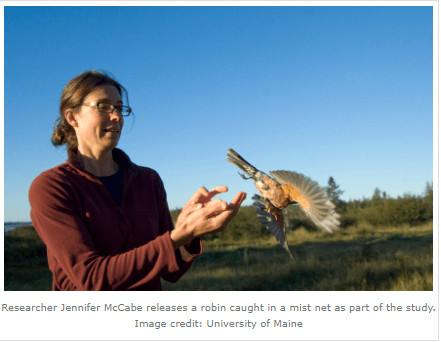Birds stopping for a break during their grueling migratory flights face a difficult tradeoff: They need to fuel up with food as efficiently as possible, but they need to avoid predators while they do it. To learn more about how they make these choices about food availability and predator risk, Jennifer McCabe and Brian Olsen of the University of Maine’s Climate Change Institute spent two years capturing birds during fall migration along the coast of Maine. Their results, published in The Auk: Ornithological Advances, show that overall birds prefer to stop in habitat with plenty of dense vegetation in which they can hide from predators such as hawks. However, the longer the migration a bird is facing, the more likely it is to take risks in order to fill up with high-energy fruit.
The six sites they monitored in 2011 and 2012 on Maine’s coastal headlands and islands fell into two categories. At some, there was no conflict between food availability and shelter from predators—birds could get both at the same time. However, at others, birds could only access the best food resources by venturing out into the open. Over the course of their two-year study, McCabe and Olsen captured almost 10,000 birds belonging to 28 species, and they found that bird abundance was higher overall in sites that didn’t force a tradeoff. The authors speculate that migrants quickly assess a site’s safety and productivity, and if a tradeoff is required, they soon move on.
While previous studies had looked at how individual species responded to these competing pressures, McCabe and Olsen’s study is unique in that it encompassed all the fruit-eating migratory birds in the area. “The neatest aspect of the study was that we used the entire migratory community to look at tradeoffs between foraging and predator avoidance similarly to behavioral research on single species, and we found similar results at the community scale as single species studies did,” says McCabe.
Habitat patches that maximize both food availability and vegetation to hide in are not the same as the mature, intact forests many songbirds prefer to breed in. Instead, they tend to be in places such as brushy forest edges, and the authors recommend that if wildlife managers want to support birds during migration as well as the breeding season, this sort of habitat cannot be overlooked, even if it appears less than pristine.
“Hawks, primarily falcons, are found in large numbers on Maine’s coastal islands during fall migration, keying in on the songbirds on migration stopover in the region. McCabe and Olsen’s manuscript does a brilliant job of assessing the balance between risking predation and fueling the energy demands for migration at six bird-banding stations along the Maine coast,” according to Glen Mittelhauser of the Maine Natural History Museum. “Overall, a well-done study that has advanced our knowledge of migration tradeoffs between food and safety and got us thinking about the importance of food resources and microhabitat on these coastal islands.”

Tradeoffs between predation risk and fruit resources shape habitat use of landbirds during autumn migration is available at http://www.aoucospubs.org/doi/full/10.1642/AUK-14-213.1. Contact: Jennifer McCabe, jennifer.mccabe@maine.edu.
About the journal: The Auk: Ornithological Advances is a peer-reviewed, international journal of ornithology that began in 1884 as the official publication of the American Ornithologists’ Union. In 2009, The Auk was honored as one of the 100 most influential journals of biology and medicine over the past 100 years.